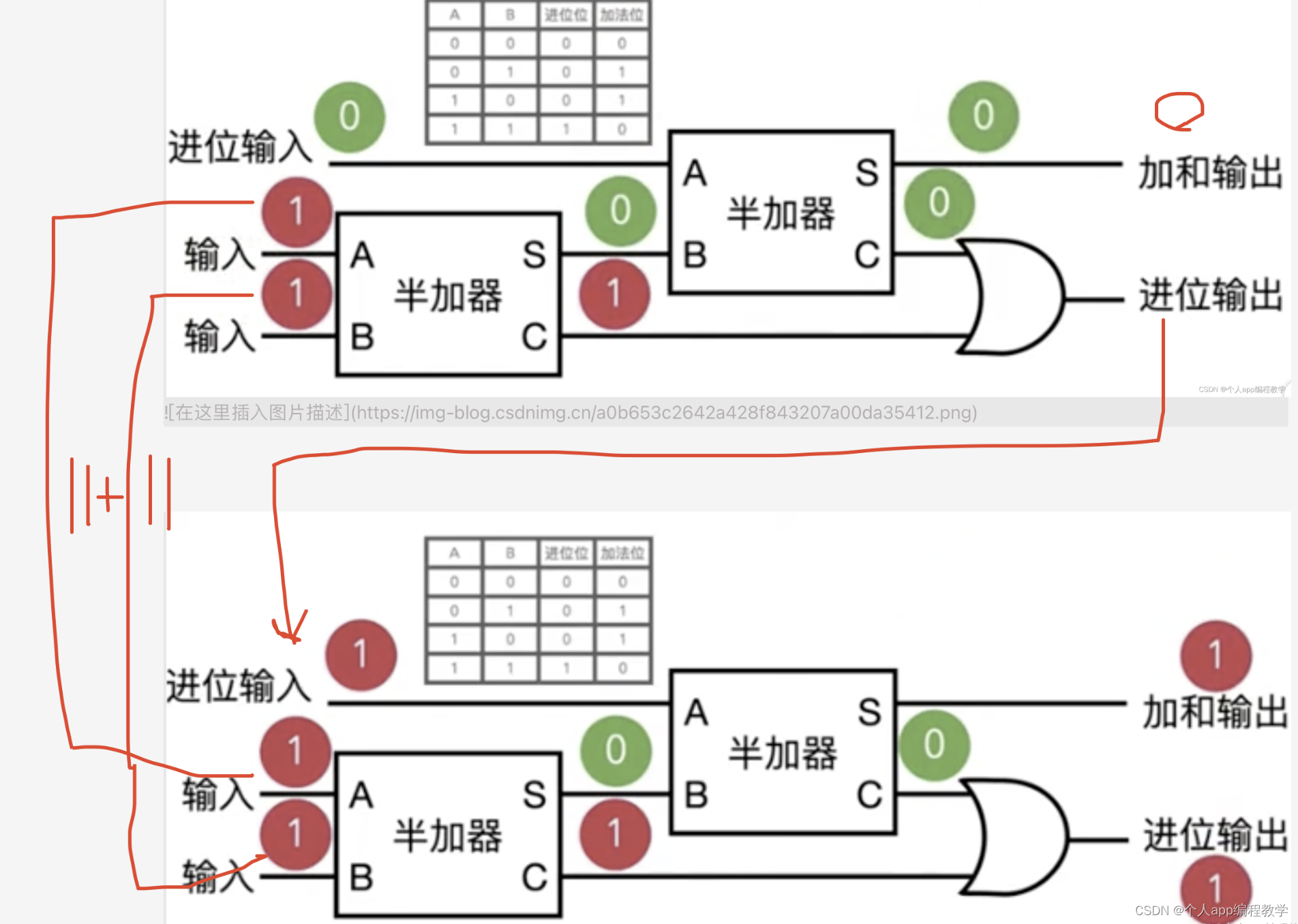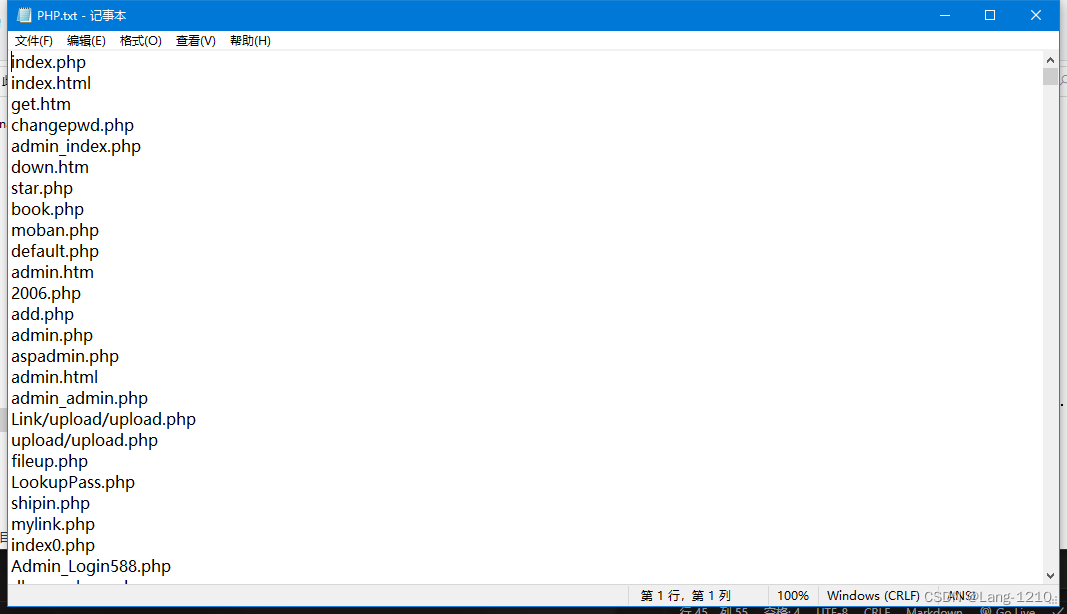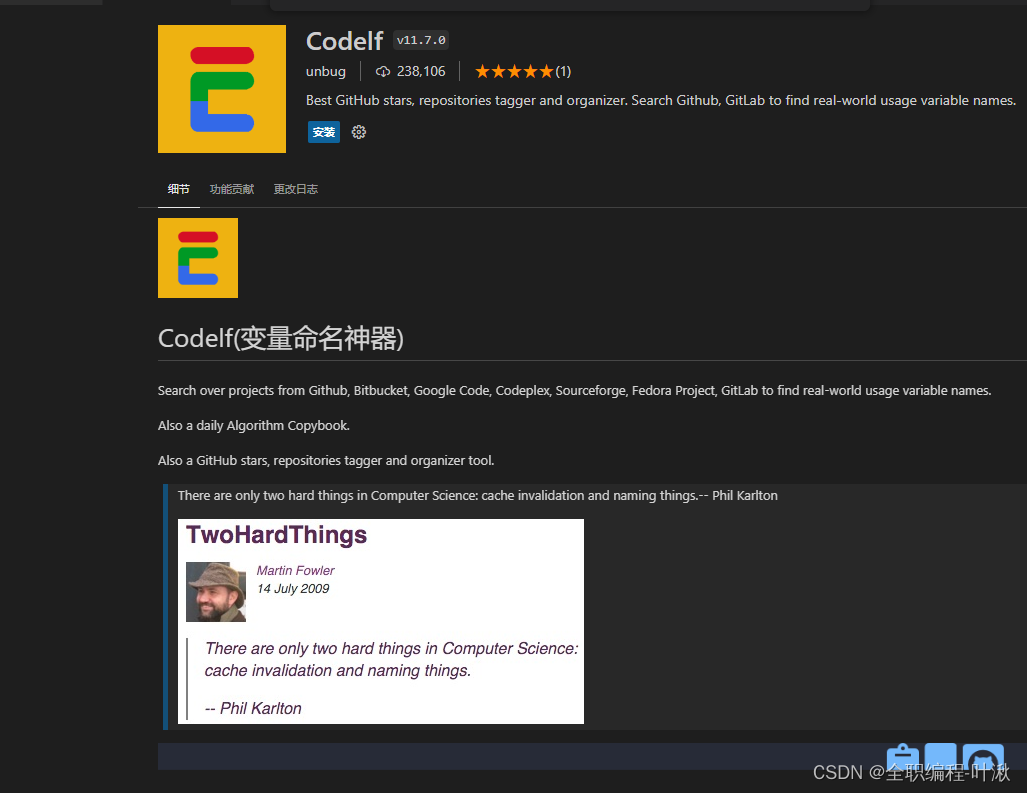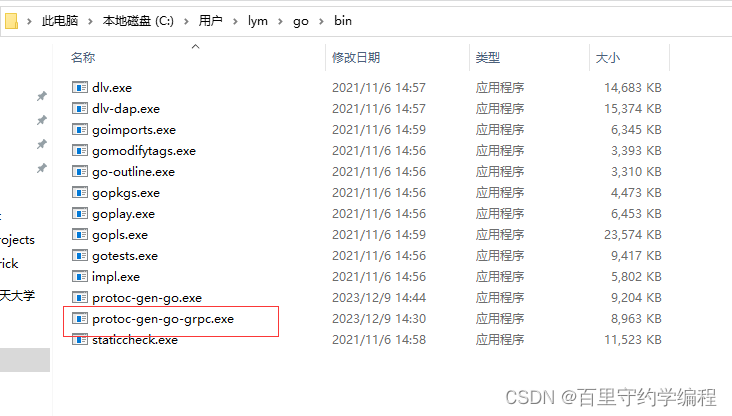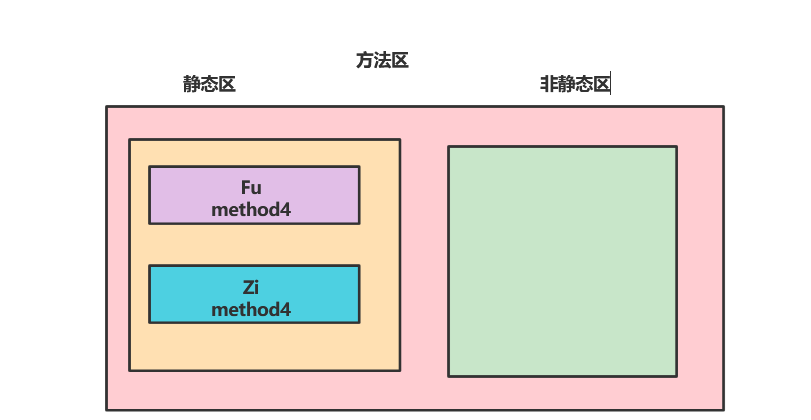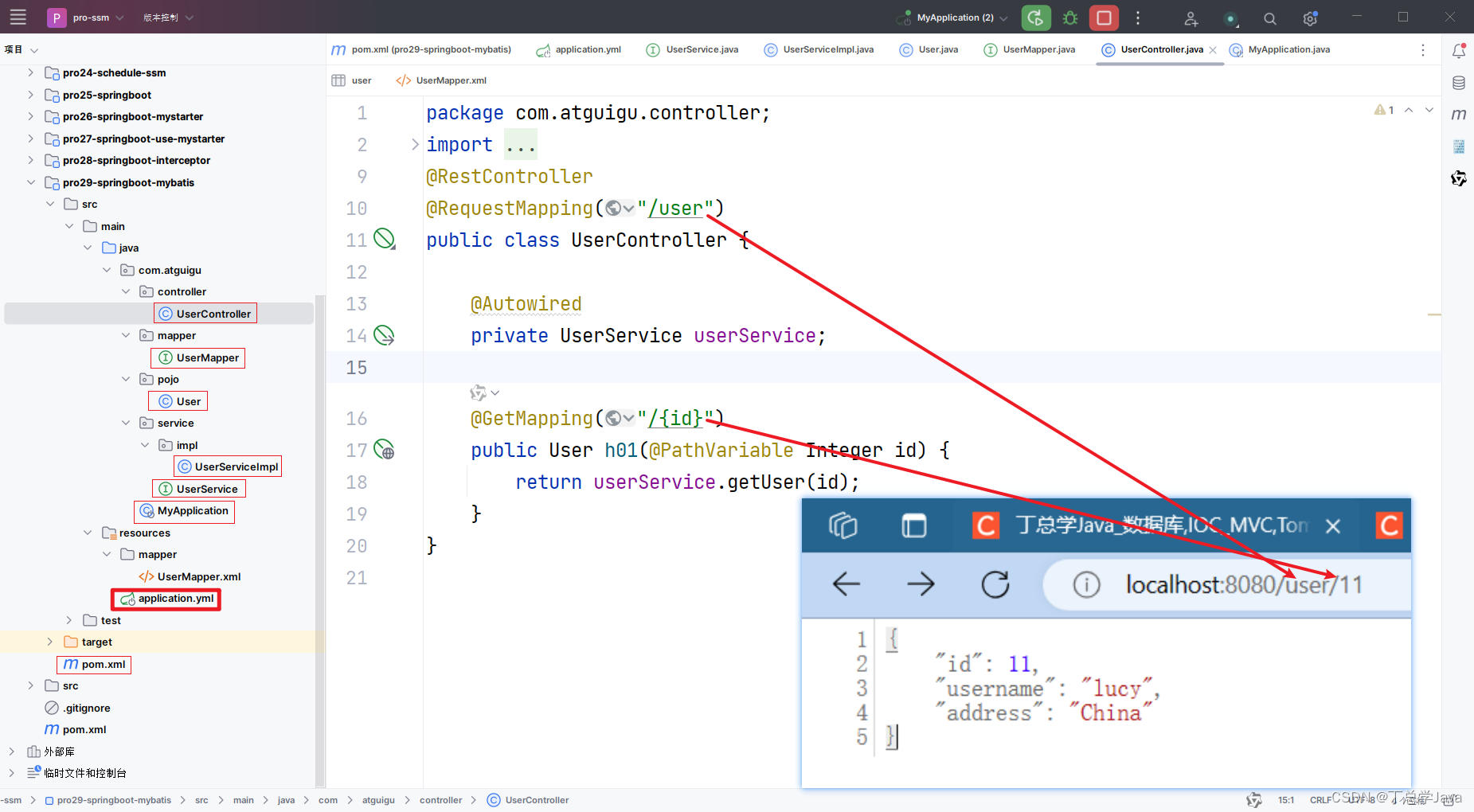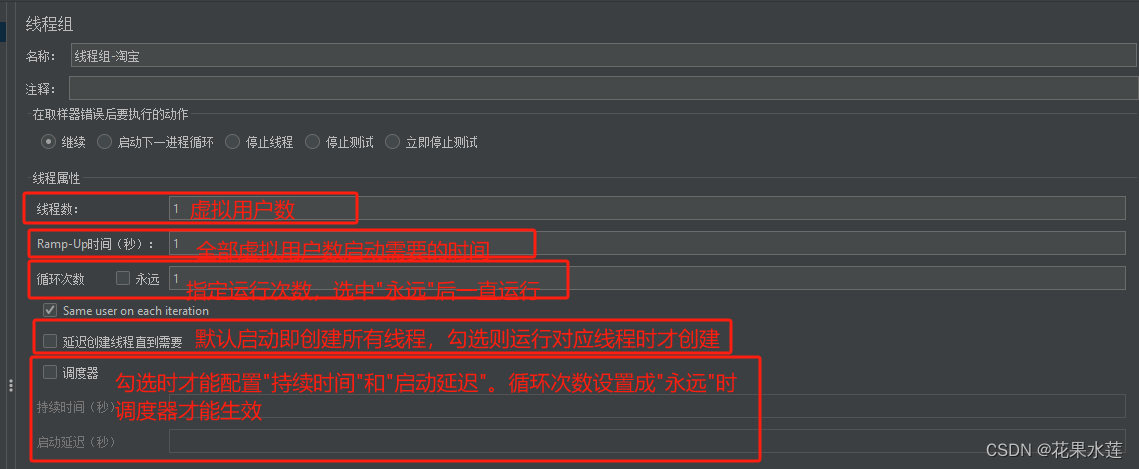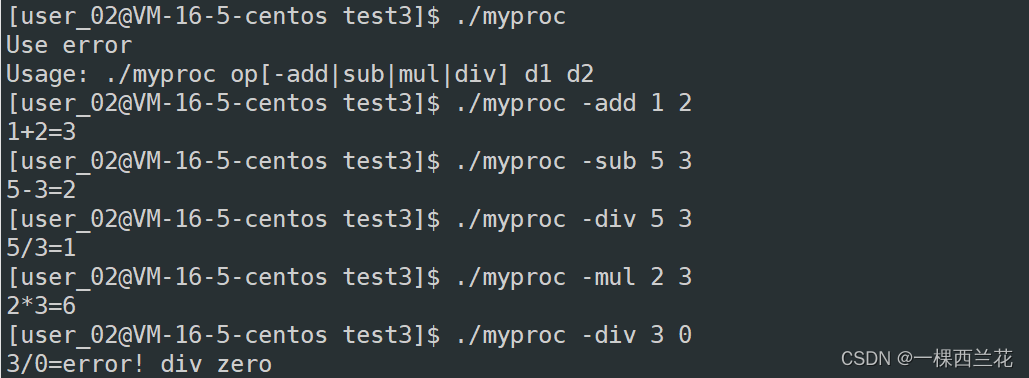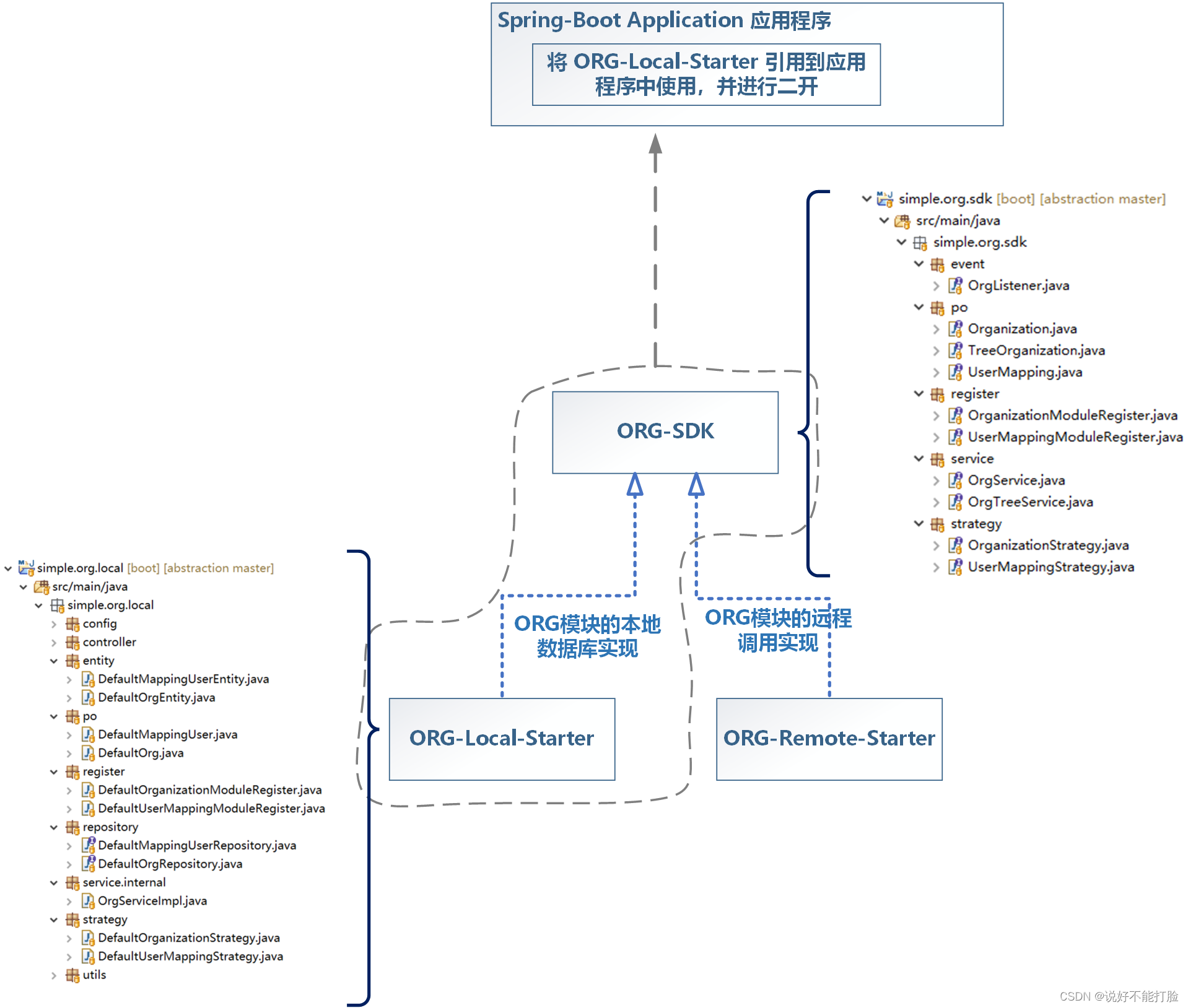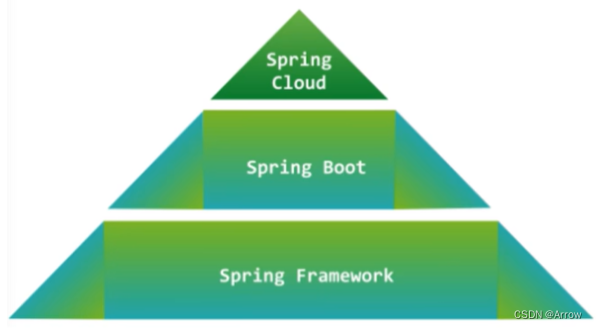1 安装librdkafka
git clone https://github.com/edenhill/librdkafka.git
cd librdkafka
git checkout v1.7.0
./configure
make
sudo make install
sudo ldconfig
在librdkafka的examples目录下会有示例程序。比如consumer的启动需要下列参数
./consumer <broker> <group.id> <topic1> <topic2>..
指定broker、group id、topic(可以订阅多个)。示例:
指定broker、group id、topic(可以订阅多个)。示例:缩略语介绍:
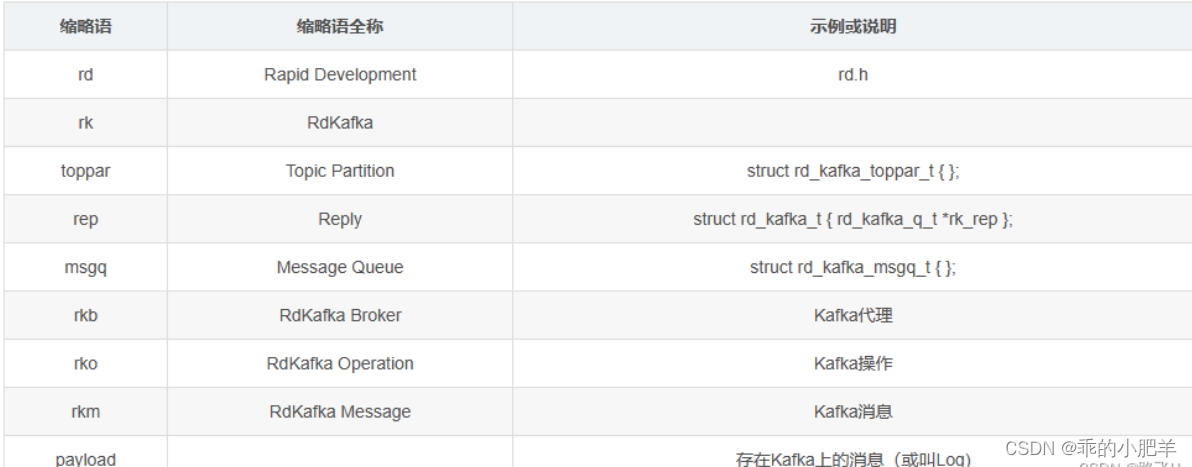
2 开启kafka相关服务
2.1 启动zookeeper
启动zookeeper可以通过下面的脚本来启动zookeeper服务,当然,也可以自己独立搭建zookeeper的集群来实现。这里我们直接使用kafka自带的zookeeper。
cd bin/
# 前台运行:
sh zookeeper-server-start.sh ../config/zookeeper.properties
# 后台运行:
sh zookeeper-server-start.sh -daemon ../config/zookeeper.properties
可以通过命令lsof -i:2181 查看zookeeper是否启动成功。
$ lsof -i:2181
COMMAND PID USER FD TYPE DEVICE SIZE/OFF NODE NAME
java 74930 fly 96u IPv6 734467 0t0 TCP *:2181 (LISTEN)
2.2 启动Kafka
启动kafka(kafka安装路径的bin目录下执行),默认启动端口9092。
sh kafka-server-start.sh -daemon ../config/server.properties
2.3 创建topic
sh kafka-topics.sh --create --zookeeper localhost:2181 --replication-factor 1 --partitions 1 --topic test
参数说明:
–create 是创建主题的的动作指令。
–zookeeper 指定kafka所连接的zookeeper服务地址。
–replicator-factor 指定了副本因子(即副本数量); 表示该topic需要在不同的broker中保存几份,这里设置成1,表示在两个broker中保存两份Partitions分区数。
–partitions 指定分区个数;多通道,类似车道。
–topic 指定所要创建主题的名称,比如test。
3 c语言操作kafka的范例
3.1 消费者
在librdkafka\examples下有consumer.c文件,该文件是一个c语言操作kafka的代码范例,内容如下。
/**
* Simple high-level balanced Apache Kafka consumer
* using the Kafka driver from librdkafka
* (https://github.com/edenhill/librdkafka)
*/
#include <stdio.h>
#include <signal.h>
#include <string.h>
#include <ctype.h>
/* Typical include path would be <librdkafka/rdkafka.h>, but this program
* is builtin from within the librdkafka source tree and thus differs. */
//#include <librdkafka/rdkafka.h>
#include "rdkafka.h"
static volatile sig_atomic_t run = 1;
/**
* @brief Signal termination of program
*/
static void stop (int sig) {
run = 0;
}
/**
* @returns 1 if all bytes are printable, else 0.
*/
static int is_printable (const char *buf, size_t size) {
size_t i;
for (i = 0 ; i < size ; i++)
if (!isprint((int)buf[i]))
return 0;
return 1;
}
int main (int argc, char **argv) {
rd_kafka_t *rk; /* Consumer instance handle */
rd_kafka_conf_t *conf; /* Temporary configuration object */
rd_kafka_resp_err_t err; /* librdkafka API error code */
char errstr[512]; /* librdkafka API error reporting buffer */
const char *brokers; /* Argument: broker list */
const char *groupid; /* Argument: Consumer group id */
char **topics; /* Argument: list of topics to subscribe to */
int topic_cnt; /* Number of topics to subscribe to */
rd_kafka_topic_partition_list_t *subscription; /* Subscribed topics */
int i;
/*
* Argument validation
*/
if (argc < 4) {
fprintf(stderr,
"%% Usage: "
"%s <broker> <group.id> <topic1> <topic2>..\n",
argv[0]);
return 1;
}
brokers = argv[1];
groupid = argv[2];
topics = &argv[3];
topic_cnt = argc - 3;
/*
* Create Kafka client configuration place-holder
*/
conf = rd_kafka_conf_new(); // 创建配置文件
/* Set bootstrap broker(s) as a comma-separated list of
* host or host:port (default port 9092).
* librdkafka will use the bootstrap brokers to acquire the full
* set of brokers from the cluster. */
if (rd_kafka_conf_set(conf, "bootstrap.servers", brokers,
errstr, sizeof(errstr)) != RD_KAFKA_CONF_OK) {
fprintf(stderr, "%s\n", errstr);
rd_kafka_conf_destroy(conf);
return 1;
}
/* Set the consumer group id.
* All consumers sharing the same group id will join the same
* group, and the subscribed topic' partitions will be assigned
* according to the partition.assignment.strategy
* (consumer config property) to the consumers in the group. */
if (rd_kafka_conf_set(conf, "group.id", groupid,
errstr, sizeof(errstr)) != RD_KAFKA_CONF_OK) {
fprintf(stderr, "%s\n", errstr);
rd_kafka_conf_destroy(conf);
return 1;
}
/* If there is no previously committed offset for a partition
* the auto.offset.reset strategy will be used to decide where
* in the partition to start fetching messages.
* By setting this to earliest the consumer will read all messages
* in the partition if there was no previously committed offset. */
if (rd_kafka_conf_set(conf, "auto.offset.reset", "earliest",
errstr, sizeof(errstr)) != RD_KAFKA_CONF_OK) {
fprintf(stderr, "%s\n", errstr);
rd_kafka_conf_destroy(conf);
return 1;
}
/*
* Create consumer instance.
*
* NOTE: rd_kafka_new() takes ownership of the conf object
* and the application must not reference it again after
* this call.
*/
// 创建一个kafka消费者
rk = rd_kafka_new(RD_KAFKA_CONSUMER, conf, errstr, sizeof(errstr));
if (!rk) {
fprintf(stderr,
"%% Failed to create new consumer: %s\n", errstr);
return 1;
}
conf = NULL; /* Configuration object is now owned, and freed,
* by the rd_kafka_t instance. */
/* Redirect all messages from per-partition queues to
* the main queue so that messages can be consumed with one
* call from all assigned partitions.
*
* The alternative is to poll the main queue (for events)
* and each partition queue separately, which requires setting
* up a rebalance callback and keeping track of the assignment:
* but that is more complex and typically not recommended. */
rd_kafka_poll_set_consumer(rk);// poll机制,设置消费者实例到poll中
/* Convert the list of topics to a format suitable for librdkafka */
// 创建主题分区列表
subscription = rd_kafka_topic_partition_list_new(topic_cnt);
for (i = 0 ; i < topic_cnt ; i++)
rd_kafka_topic_partition_list_add(subscription,
topics[i],
/* the partition is ignored
* by subscribe() */
RD_KAFKA_PARTITION_UA);
/* Subscribe to the list of topics */
err = rd_kafka_subscribe(rk, subscription);
if (err) {
fprintf(stderr,
"%% Failed to subscribe to %d topics: %s\n",
subscription->cnt, rd_kafka_err2str(err));
rd_kafka_topic_partition_list_destroy(subscription);
rd_kafka_destroy(rk);
return 1;
}
fprintf(stderr,
"%% Subscribed to %d topic(s), "
"waiting for rebalance and messages...\n",
subscription->cnt);
rd_kafka_topic_partition_list_destroy(subscription);
/* Signal handler for clean shutdown */
signal(SIGINT, stop);
/* Subscribing to topics will trigger a group rebalance
* which may take some time to finish, but there is no need
* for the application to handle this idle period in a special way
* since a rebalance may happen at any time.
* Start polling for messages. */
while (run) {
rd_kafka_message_t *rkm;
rkm = rd_kafka_consumer_poll(rk, 100);
if (!rkm)
continue; /* Timeout: no message within 100ms,
* try again. This short timeout allows
* checking for `run` at frequent intervals.
*/
/* consumer_poll() will return either a proper message
* or a consumer error (rkm->err is set). */
if (rkm->err) {
/* Consumer errors are generally to be considered
* informational as the consumer will automatically
* try to recover from all types of errors. */
fprintf(stderr,
"%% Consumer error: %s\n",
rd_kafka_message_errstr(rkm));
rd_kafka_message_destroy(rkm);
continue;
}
/* Proper message. */
printf("Message on %s [%"PRId32"] at offset %"PRId64":\n",
rd_kafka_topic_name(rkm->rkt), rkm->partition,
rkm->offset);
/* Print the message key. */
if (rkm->key && is_printable(rkm->key, rkm->key_len))
printf(" Key: %.*s\n",
(int)rkm->key_len, (const char *)rkm->key);
else if (rkm->key)
printf(" Key: (%d bytes)\n", (int)rkm->key_len);
/* Print the message value/payload. */
if (rkm->payload && is_printable(rkm->payload, rkm->len))
printf(" Value: %.*s\n",
(int)rkm->len, (const char *)rkm->payload);
else if (rkm->payload)
printf(" Value: (%d bytes)\n", (int)rkm->len);
rd_kafka_message_destroy(rkm);
}
/* Close the consumer: commit final offsets and leave the group. */
fprintf(stderr, "%% Closing consumer\n");
rd_kafka_consumer_close(rk);
/* Destroy the consumer */
rd_kafka_destroy(rk);
return 0;
}
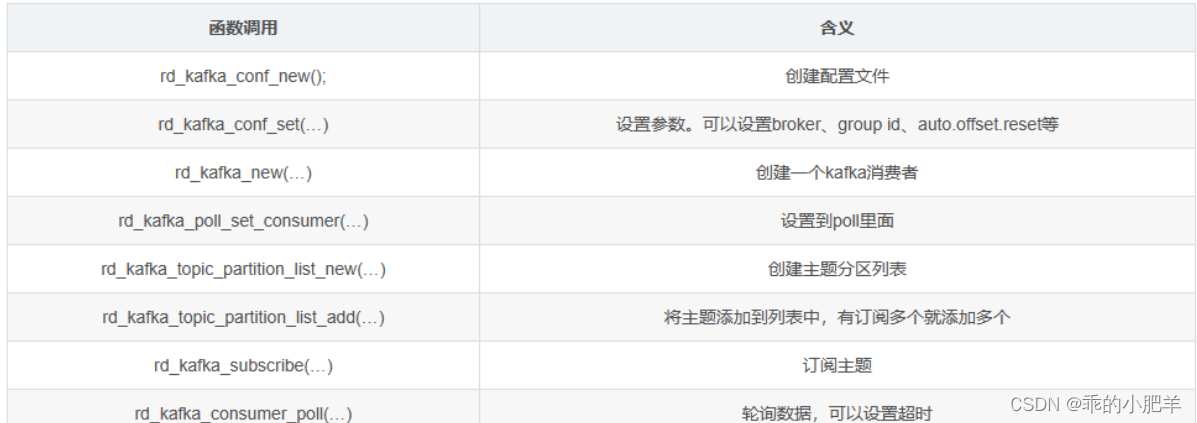
3.2 生产者
在librdkafka\examples下有producer.c文件,该文件是一个c语言操作kafka的代码范例,内容如下。
/**
* Simple Apache Kafka producer
* using the Kafka driver from librdkafka
* (https://github.com/edenhill/librdkafka)
*/
#include <stdio.h>
#include <signal.h>
#include <string.h>
/* Typical include path would be <librdkafka/rdkafka.h>, but this program
* is builtin from within the librdkafka source tree and thus differs. */
#include "rdkafka.h"
static volatile sig_atomic_t run = 1;
/**
* @brief Signal termination of program
*/
static void stop (int sig) {
run = 0;
fclose(stdin); /* abort fgets() */
}
/**
* @brief Message delivery report callback.
*
* This callback is called exactly once per message, indicating if
* the message was succesfully delivered
* (rkmessage->err == RD_KAFKA_RESP_ERR_NO_ERROR) or permanently
* failed delivery (rkmessage->err != RD_KAFKA_RESP_ERR_NO_ERROR).
*
* The callback is triggered from rd_kafka_poll() and executes on
* the application's thread.
*/
static void dr_msg_cb (rd_kafka_t *rk,
const rd_kafka_message_t *rkmessage, void *opaque) {
if (rkmessage->err)
fprintf(stderr, "%% Message delivery failed: %s\n",
rd_kafka_err2str(rkmessage->err));
else
fprintf(stderr,
"%% Message delivered (%zd bytes, "
"partition %"PRId32")\n",
rkmessage->len, rkmessage->partition);
/* The rkmessage is destroyed automatically by librdkafka */
}
int main (int argc, char **argv) {
rd_kafka_t *rk; /* Producer instance handle */
rd_kafka_conf_t *conf; /* Temporary configuration object */
char errstr[512]; /* librdkafka API error reporting buffer */
char buf[512]; /* Message value temporary buffer */
const char *brokers; /* Argument: broker list */
const char *topic; /* Argument: topic to produce to */
/*
* Argument validation
*/
if (argc != 3) {
fprintf(stderr, "%% Usage: %s <broker> <topic>\n", argv[0]);
return 1;
}
brokers = argv[1];
topic = argv[2];
/*
* Create Kafka client configuration place-holder
*/
conf = rd_kafka_conf_new();
/* Set bootstrap broker(s) as a comma-separated list of
* host or host:port (default port 9092).
* librdkafka will use the bootstrap brokers to acquire the full
* set of brokers from the cluster. */
if (rd_kafka_conf_set(conf, "bootstrap.servers", brokers,
errstr, sizeof(errstr)) != RD_KAFKA_CONF_OK) {
fprintf(stderr, "%s\n", errstr);
return 1;
}
/* Set the delivery report callback.
* This callback will be called once per message to inform
* the application if delivery succeeded or failed.
* See dr_msg_cb() above.
* The callback is only triggered from rd_kafka_poll() and
* rd_kafka_flush(). */
rd_kafka_conf_set_dr_msg_cb(conf, dr_msg_cb);
/*
* Create producer instance.
*
* NOTE: rd_kafka_new() takes ownership of the conf object
* and the application must not reference it again after
* this call.
*/
rk = rd_kafka_new(RD_KAFKA_PRODUCER, conf, errstr, sizeof(errstr));
if (!rk) {
fprintf(stderr,
"%% Failed to create new producer: %s\n", errstr);
return 1;
}
/* Signal handler for clean shutdown */
signal(SIGINT, stop);
fprintf(stderr,
"%% Type some text and hit enter to produce message\n"
"%% Or just hit enter to only serve delivery reports\n"
"%% Press Ctrl-C or Ctrl-D to exit\n");
while (run && fgets(buf, sizeof(buf), stdin)) {
size_t len = strlen(buf);
rd_kafka_resp_err_t err;
if (buf[len-1] == '\n') /* Remove newline */
buf[--len] = '\0';
if (len == 0) {
/* Empty line: only serve delivery reports */
rd_kafka_poll(rk, 0/*non-blocking */);
continue;
}
/*
* Send/Produce message.
* This is an asynchronous call, on success it will only
* enqueue the message on the internal producer queue.
* The actual delivery attempts to the broker are handled
* by background threads.
* The previously registered delivery report callback
* (dr_msg_cb) is used to signal back to the application
* when the message has been delivered (or failed).
*/
retry:
err = rd_kafka_producev(
/* Producer handle */
rk,
/* Topic name */
RD_KAFKA_V_TOPIC(topic),
/* Make a copy of the payload. */
RD_KAFKA_V_MSGFLAGS(RD_KAFKA_MSG_F_COPY),
/* Message value and length */
RD_KAFKA_V_VALUE(buf, len),
/* Per-Message opaque, provided in
* delivery report callback as
* msg_opaque. */
RD_KAFKA_V_OPAQUE(NULL),
/* End sentinel */
RD_KAFKA_V_END);
if (err) {
/*
* Failed to *enqueue* message for producing.
*/
fprintf(stderr,
"%% Failed to produce to topic %s: %s\n",
topic, rd_kafka_err2str(err));
if (err == RD_KAFKA_RESP_ERR__QUEUE_FULL) {
/* If the internal queue is full, wait for
* messages to be delivered and then retry.
* The internal queue represents both
* messages to be sent and messages that have
* been sent or failed, awaiting their
* delivery report callback to be called.
*
* The internal queue is limited by the
* configuration property
* queue.buffering.max.messages */
rd_kafka_poll(rk, 1000/*block for max 1000ms*/);
goto retry;
}
} else {
fprintf(stderr, "%% Enqueued message (%zd bytes) "
"for topic %s\n",
len, topic);
}
/* A producer application should continually serve
* the delivery report queue by calling rd_kafka_poll()
* at frequent intervals.
* Either put the poll call in your main loop, or in a
* dedicated thread, or call it after every
* rd_kafka_produce() call.
* Just make sure that rd_kafka_poll() is still called
* during periods where you are not producing any messages
* to make sure previously produced messages have their
* delivery report callback served (and any other callbacks
* you register). */
rd_kafka_poll(rk, 0/*non-blocking*/);
}
/* Wait for final messages to be delivered or fail.
* rd_kafka_flush() is an abstraction over rd_kafka_poll() which
* waits for all messages to be delivered. */
fprintf(stderr, "%% Flushing final messages..\n");
rd_kafka_flush(rk, 10*1000 /* wait for max 10 seconds */);
/* If the output queue is still not empty there is an issue
* with producing messages to the clusters. */
if (rd_kafka_outq_len(rk) > 0)
fprintf(stderr, "%% %d message(s) were not delivered\n",
rd_kafka_outq_len(rk));
/* Destroy the producer instance */
rd_kafka_destroy(rk);
return 0;
}
3.3 生产者和消费者的交互
(1)启动消费者。
./consumer localhost:9092 0 test
1
显示:
% Subscribed to 1 topic(s), waiting for rebalance and messages...
1
(2)启动生产者。
./producer localhost:9092 test
总结
- 一个分区只能被一个消费者读取。如果一个topic只有一个分区,多个消费者读取时只有一个消费者能读到数据;单个分区开启多个消费者去读取数据是没有意义的。
